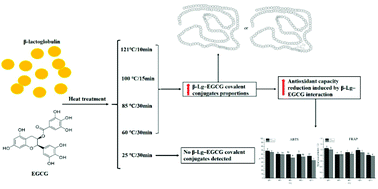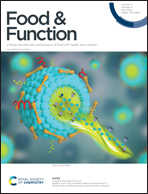Analysis of β-lactoglobulin–epigallocatechin gallate interactions: the antioxidant capacity and effects of polyphenols under different heating conditions in polyphenolic–protein interactions
Abstract
The interaction and antioxidant capacity between epigallocatechin gallate (EGCG) and β-lactoglobulin (β-Lg) under thermal treatments at 25–121 °C were investigated in this study. Fluorescence spectroscopy analysis showed that EGCG complexed with β-Lg mainly via non-covalent interactions and the binding affinity of EGCG to β-Lg was enhanced with heat treatment. EGCG showed a strong binding affinity to β-Lg after 85 °C heat treatment was applied, with a Ka of 30.69 (±0.87) × 105 M−1 (pH 6.8, 298 K). Circular dichroism (CD) results showed that heat treatment did not result in greatly affected changes in the β-Lg secondary structure induced by β-Lg–EGCG interactions. MALDI-TOF/TOF-MS analysis showed that β-Lg–EGCG covalent conjugates initially formed after heat was applied at 60 °C, and their proportions increased under heat treatment ranging from 85 to 121 °C. The amino group of a lysine residue was further confirmed as the covalent binding site of EGCG to β-Lg. The β-Lg–EGCG interaction showed little effect on the antioxidant capacity (ABTS and ferric reducing antioxidant power (FRAP) values) of EGCG after heat treatment at 25–60 °C, but did induce an obvious reduction at temperatures above 85 °C. This study will provide the foundation for the use of EGCG in processing dairy products (such as milk tea beverages) with desirable nutrition and physiological functions.

- This article is part of the themed collection: Food & Function Recent HOT articles


 Please wait while we load your content...
Please wait while we load your content...